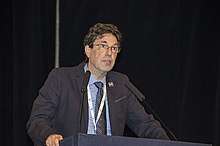Thomas Lengauer
Thomas Lengauer (born November 12, 1952) is a German computer scientist, working in the fields of computational biology, computational chemistry and combinatorial optimization.[2][3]
Thomas Lengauer | |
|---|---|
 Thomas Lengauer in 2017. | |
| Born | November 12, 1952 |
| Alma mater |
|
| Awards | Konrad Zuse Medal (2003) |
| Scientific career | |
| Fields | |
| Theses |
|
| Doctoral advisors |
|
| Doctoral students | Christoph Bock[1] |
| Website | www |
Education
Lengauer studied Mathematics at the Free University of Berlin, earning his Diploma in 1975 and a Dr. rer. nat. (equivalent to a PhD) in 1976. His thesis studied structural aspects of concurrency. Lengauer later gained an MSc (1977) and a PhD (1979) in computer science, both from Stanford University.[4]
Work and research
After a short period working at Bell Labs and Saarland University, Lengauer became Professor of Computer Science at University of Paderborn in 1984. From 1992 to 2001 he was Professor of Computer Science at the University of Bonn and Director of the German National Center for Information Technology.[5] Since 2001, he has been a Director at the Max Planck Institute for Informatics.[6]
With his Stanford PhD advisor Robert Tarjan, he is known for the Lengauer–Tarjan algorithm in graph theory.[7]
Since the early 1990s his research has been focused in computational biology, particularly the prediction of protein structure and function, and computational drug screening and design.[5]
Awards and honours
In 2003, Lengauer was awarded the Konrad Zuse Medal, the highest award of the Gesellschaft für Informatik (German Informatics Society).[8]
Since 2014, Lengauer has been Vice President of the International Society for Computational Biology (ISCB).[9][10] He was elected as a Fellow of the ISCB in 2015.[11] In September 2016 it was announced that Lengauer will become the next President of the ISCB, serving for three years from January 2018. He will be President-Elect through 2017.[12]
Personal life
Lengauer's twin brother Christian Lengauer was a Professor in the Faculty of Informatics and Mathematics at the University of Passau.[13][14]
References
- Bock, Christoph (2008). Computational Epigenetics. mpg.de (PhD thesis). Saarland University. OCLC 472653426. Retrieved 23 July 2017.
- "Homepage (Max-Planck-Institut für Informatik)". bioinf.mpi-inf.mpg.de. Retrieved 31 August 2016.
- Thomas Lengauer at DBLP Bibliography Server

- "Homepage (Max-Planck-Institut für Informatik) | Academic". bioinf.mpi-inf.mpg.de. Retrieved 31 August 2016.
- "BioSolveIT GmbH – Thomas Lengauer". www.biosolveit.de. Retrieved 31 August 2016.
- Bioinformatics – From Genomes to Therapies. 2007. doi:10.1002/9783527619368. ISBN 9783527619368.
- Lengauer, Thomas; Tarjan, Robert Endre (1 January 1979). "A fast algorithm for finding dominators in a flowgraph". ACM Transactions on Programming Languages and Systems. 1 (1): 121–141. CiteSeerX 10.1.1.117.8843. doi:10.1145/357062.357071.
- "BioSolveIT GmbH – Award: Thomas Lengauer receives the acclaimed Konrad-Zuse-Medal (07.07.2003)". www.biosolveit.de. Retrieved 31 August 2016.
- "Aug 09, 2013: ISCB Announces Results of the Officer Elections". www.iscb.org. Retrieved 12 September 2016.
- "Officers and Directors". www.iscb.org. Retrieved 31 August 2016.
- "Feb 20, 2015: Meet the ISCB Fellows Class of 2015". www.iscb.org. Retrieved 31 August 2016.
- "September 12, 2016 - ISCB Announces Results of the 2016 Officer and Student Council Leadership Elections!". www.iscb.org. Retrieved 13 September 2016.
- "f2.pdf" (PDF). Retrieved 4 September 2016.
- "Homepage of Christian Lengauer". www.infosun.fim.uni-passau.de. Retrieved 4 September 2016.